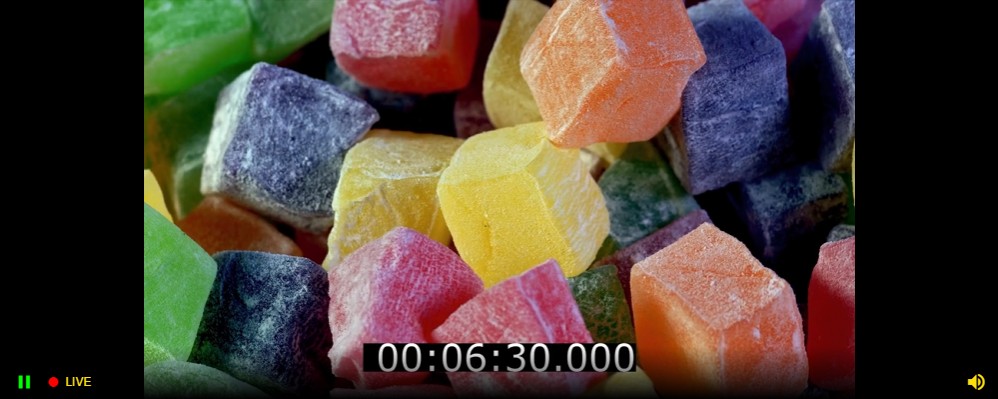CSS Customizations (Deprecated)
Further customize your THEOlive player through API
At this point, you have a working self-hosted player and knowledge about the API. Making use of some additional HTML, CSS and JavaScript we can modify the aspect and tap into the player with the aid of the available API. Let's dive into some specific examples of player customization.
Standard customizations available
The standard customization options available for the embedded player (e.g. adding poster image, switching on/off autoplay, tailoring the colors, etc.), are also possible for the self-hosted player. Use the THEOlive console or the THEOlive API for this. For more information, see Customize your THEOlive player.
Customization examples
Example 1 - Change the big play button with CSS
It’s possible to customize the big play button, to give it your own look and feel. There are many things you can do here, but we’ll share a few ideas to get you started.
1.1 - Make the big play button more lively / interactive
In order to do this, you can add a transition that increases the button size when hovering it:
.theoplayer-skin .vjs-big-play-button:hover {
background: none;
-webkit-transition-duration: 0.2s;
-moz-transition-duration: 0.2s;
transition-duration: 0.2s;
transform: translate(-50%, -50%) scale(1.2);
transition: transform 0.2s;
}

1.2 - Use another image
You might want to use another image for your big play button. In the following example, we remove the current svg and replace it with another image.
.theo-big-play-button-svg-container svg {
display: none;
}
.theoplayer-skin .vjs-big-play-button {
content: "";
background: url("data:image/svg+xml;base64,PD94bWwgd…vc3ZnPg==")
no-repeat 0 0!important;
/* background: url('http://i.stack.imgur.com/LT3WE.png') no-repeat 0 0; */ /* Use image instead */
background-size: 100%!important;
display: block;
}
1.3 - Change the spotlight
You might want to remove or alter the spotlight that currently appears around the button, on focus (hovering the player).
.theoplayer-skin:hover .vjs-big-play-button:after,
.theoplayer-skin .vjs-big-play-button:focus:after {
opacity: 1!important; /* make the spotlight always visible */
/*opacity: 0!important;*/ /* hide it */
color:lawngreen; /* give it a color */
}
Example 2 - Change the control bar
In addition to changing control bar colors, which is possible via the THEOlive API and console, it is possible to customize the control bar further via the THEOlive NPM player. This section provides a number of examples.
2.1 - Always show/hide the control bar
A typical use case for hiding the control bar is if you don’t want your viewer to have control over the video (e.g.: pause, fullscreen). In other cases, you might want to avoid the control bar disappearing.
.vjs-control-bar {
opacity:0!important;
display:none!important
}
.vjs-user-inactive .vjs-control-bar {
opacity:1!important
}
2.2 - Customize single buttons
Through the THEOlive API and the console, you can change the colors of the control bar. However, you can’t act on single buttons. In the following example, we are hiding the fullscreen button, moving the mute button and changing the color of the play button.
.vjs-mute-control {
order:9!important
}
.vjs-play-control {
color:lime!important
}
.vjs-fullscreen-control {
display: none!important
}
Example 3 - Customize the player
You can also further customize the player itself by changing shape, colors and so on.
3.1 - Fill completely a container element
As is, the player will fill its container element depending only on its width and maintain the optimal shape for a 16:9 video. You can give it a specific size or have it completely fill a container element. The video element will maintain its own aspect ratio, therefore the images won’t be altered.
<div id="containerDiv" style="width:1000px;height:400px"></div>
.video-js {
width: 100% !important;
height: 100% !important;
padding: 0 !important;
}
// Add the player to the page at your desired location:
/*document.body.append(player);*/
document.querySelector('#containerDiv').append(player);

3.2 - Change the background color
Currently the player’s background is black. It can be changed as follows:
.video-js .theo-player-wrapper {
background-color: darkblue;
}
Example 4 - Show elements based on the player API
4.1 - Add a warning
If playback starts muted, warn the viewer and give the possibility to unmute it by clicking the warning
<div id="mutedNotice">
<h3>Your player is muted</h3>
<p>Click here to unmute your player</p>
</div>
#mutedNotice {
text-align:center;
border-radius:1em;
border:1px solid #ccc;
padding: 1em 2em;
display:none;
width:max-content;
margin:1em auto;
background-color:rgba(255,255,0,.1);
position:relative;
box-shadow: 2px 2px 5px #ccc;
cursor: pointer;
}
// Make the notice appear if the player is muted on
let mutedNotice = document.querySelector('#mutedNotice');
let myInterval = setInterval(showMutedNotice, 500);
function showMutedNotice() {
if (!player.paused) {
if (player.muted) {
mutedNotice.style.display = "block";
}
clearInterval(myInterval);
}
}
// make the notice unmute the player and disappear when clicked
mutedNotice.addEventListener('click', ()=>{
player.muted = false;
mutedNotice.style.display = "none";
});
Updated about 2 years ago